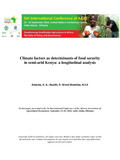| dc.description.abstract | Food security in the arid and semi-arid areas (ASALs) of Kenya is linked to climate and socio-economic factors. This study was conducted in two ASAL counties of Kenya, Kajiado and Makueni, inhabited by pastoral communities. Both primary and secondary data were collected on climate and socio-economic aspects from published and unpublished documents. Time series data covering a 31 year period were collected on rainfall amounts, rain days, temperature, beef and maize prices, stocking, livestock sales and land under cultivation to generate descriptive statistics and regression results based on the OLS, GLS and AR models. Livestock contributed 78.2% and 38.3% of total income in Kajiado and Makueni Counties respectively. Crops contributed more to the total income in Makueni County at 52.7% compared to Kajiado County at 6.9%. Of the three models tested, the GLS was found to be the most appropriate based on the number of significant variables and the estimated R2 value. The model showed that rainfall, temperature, rain days, and beef and maize prices influence income in Kajiado and Makueni Counties. Therefore, creation of micro-climates through agroforestry moderates temperatures, attracts rainfall, sequesters carbon and provides services such as food, timber, raw materials and employment. Moreover, initiatives that regulate beef and maize prices ensure predictable markets and income in both counties. | en_US |

